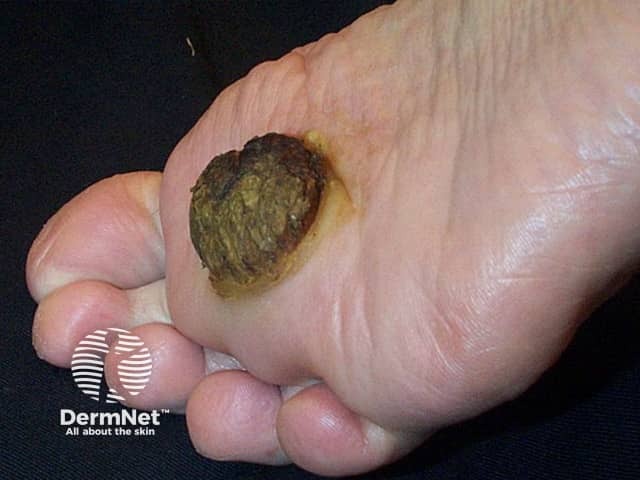Main menu
Common skin conditions

NEWS
Join DermNet PRO
Read more
Quick links
Carcinoma cuniculatum — extra information
Carcinoma cuniculatum
Author: Dr David Veitch, Dermatology Registrar, Department of Dermatology, Leicester Royal Infirmary, Leicester, United Kingdom. DermNet Editor in Chief: Adjunct A/Prof Amanda Oakley, Dermatologist, Hamilton, New Zealand. Copy edited by Gus Mitchell/Maria McGivern. August 2018.
Introduction Demographics Causes Clinical features Complications Diagnosis Differential diagnoses Treatment Outcome
What is carcinoma cuniculatum?
Carcinoma cuniculatum is a rare, slow-growing variant of cutaneous squamous cell carcinoma (SCC). It tends to affect the sole of the foot, but it can occur at other sites, such as the oral cavity and genitals.
Carcinoma cuniculatum is also known as:
- Epithelioma cuniculatum
- Ackerman tumour
- Verrucous carcinoma
- Buschke–Löwenstein tumour
- Cutis papillomatosis carcinoides of Gottron.

Carcinoma cuniculatum
Who gets carcinoma cuniculatum?
Risk factors for carcinoma cuniculatum include viral warts due to human papillomavirus infection (HPV), tobacco (smoking or snuff), chemical mutagens, and in the vulva, lichen sclerosus [1]. The genital variant tends to affect older people.
What causes carcinoma cuniculatum?
The above risk factors give rise to a variant of low–grade SCC. The genetic factors are unknown.
What are the clinical features of carcinoma cuniculatum?
Carcinoma cuniculatum is a solitary, slow growing, warty, papillomatous plaque.
- It usually develops on the foot, oral cavity, nails, or genitals.
- It rarely ulcerates.
- When located on the foot, lesions are usually found on the sole of the foot (53%), toes (21%), or heel (16%) [2].
- On the penis, it accounts for < 1% of all SCC variants.
- In the oral cavity, it can appear as a warty white neoplasm [3].
What are the complications of carcinoma cuniculatum?
In rare cases, carcinoma cuniculatum can metastasise.
How is carcinoma cuniculatum diagnosed?
Although the diagnosis of carcinoma cuniculatum may be suspected clinically, biopsy is essential to confirm the diagnosis.
What is the differential diagnosis for carcinoma cuniculatum?
The differential diagnosis for carcinoma may include:
- Cutaneous SCC — note that carcinoma cuniculatum rarely ulcerates whereas SCC commonly does
- Viral wart — however, warts are smaller than carcinoma cuniculatum and do not ulcerate.
What is the treatment for carcinoma cuniculatum?
Carcinoma cuniculatum is usually treated by surgical excision. Oral retinoids, methotrexate, laser surgery, and topical imiquimod have been reported to be effective where surgery is contraindicated [2,3].
Radiotherapy is to be avoided, as this can trigger the development of an anaplastic form of SCC.
What is the outcome for carcinoma cuniculatum?
The prognosis of carcinoma cuniculatum is very good if treated with surgical excision. Distant or local lymph node metastases are rare.
References
- De Berker. Acquired disorders of the nails and nail unit. In: Griffiths C, Barker J, Bleiker T, Chalmers R, Creamer D (eds). Rook's textbook of dermatology. 9th edn, vol 3. Oxford: Wiley-Blackwell Scientific Publications, 2016: chapter 95.
- Cunliffe T. Carcinoma cuniculatum. Primary Care Dermatological Society. Updated April 2018. Available at http://www.pcds.org.uk/clinical-guidance/verrucous-carcinoma.
- Scully C. Dermatoses of the oral cavity and lips. In: Griffiths C, Barker J, Bleiker T, Chalmers R, Creamer D (eds). Rook's textbook of dermatology. 9th edn, vol 3. Oxford: Wiley-Blackwell Scientific Publications, 2016: chapter 110.
On DermNet
